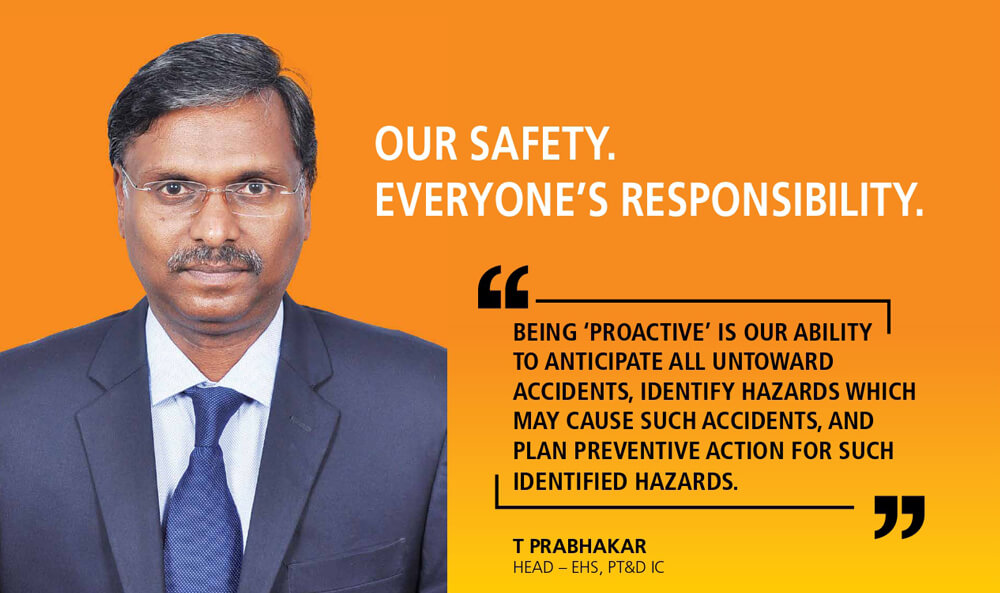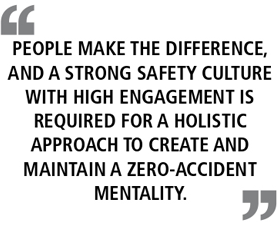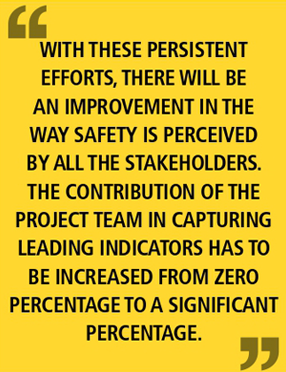
The electrical projects of PT&D IC come under the high-risk category, as electrical hazards are hidden. Tower erection works too are in the highrisk category due to the nature of the job and their locations, which could be just about anywhere: in paddy fields, on hilly terrains, in the middle of deserts, inside rivers, etc. Likewise, in distribution projects where we electrify villages and cities replacing old overhead lines with new conductors, the challenges are of working near/below charged overhead lines, in remote villages, in congested city roads, inside tunnels, and the like, where too the hazards are high.
The projects in utility power distribution and transmission lines are cross-country jobs and on an average we work at 300 locations per day in various areas. The work methodology for such high-risk activities is prepared taking into consideration the hazards involved in such type of work.
Electricity is an unknown hazard, more dangerous compared to other known construction hazards. Electrocution can occur due to induction effect, back feeding, and current leakage, and the reasons for the same can be better understood only if one understands electricity well. Though these hazards are invisible, they have the potential to create huge damage to human life.
Executing projects in such a challenging environment requires a thorough survey to understand the risks involved and their severity. Working on/near live lines requires shutdowns to prevent accidents. Utility clients at times insist on executing the work without shutdowns due to pressure from the public/locals and/or the fear of revenue loss.
The challenge to achieve zero injuries
The challenge for PT&D IC is to implement safety systems and achieve zero injuries when executing high-risk jobs spread across various locations and different terrains, for which the involvement and commitment of the entire site team is imperative. People make the difference, and a strong safety culture with high engagement is required for a holistic approach to create and maintain a zero-accident mentality.
These challenges in safety can only be overcome if we bring in a culture of proactiveness, which is different from a reactive safety culture. Being ‘proactive’ is our ability to anticipate all untoward accidents, identify hazards which may cause such accidents, and plan preventive action for such identified hazards. However, it is impossible for one or two safety officers at sites to identify all the hazards at construction sites. Engagement and commitment of all the stakeholders are essential to achieve this.
Safety is the responsibility of every individual working at project sites. The site team is not only responsible but also accountable. A safety engineer at site can capture unsafe behaviours/conditions at sites. But he can miss to capture hazards due to limitations. If we must change the culture, then instead of expecting an engineer from the safety department to identify hazards, everybody should identify hazards and take corrective action.

Nobody should walk past any unsafe act and/or unsafe condition. The involvement of the project leader is more critical to improve the safety culture at site since they are the ones who must demonstrate the importance of safety.
When the Project Manager takes proactive action by capturing hazards, the behaviour of the entire project team will certainly change, and they will all improve their focus on safety. If there is commitment from each one to improve safety, they must walk the talk. It is not only the Project Manager but also the site engineers, section in-charges, and construction managers who also play a major role in implementing safety systems. All the team members, irrespective of their role, should prioritize safety and work accordingly at sites. Considering the high-risk activities, unless all the stakeholders are involved in safety implementation, our vision to achieve Mission Zero Harm will not be possible.
We believe that a better safety culture can be achieved only by means of engagement and everyone’s commitment.
To change the culture of safety through the involvement of every member of the project team calls for the following approach:
- Capture leading indicators extensively
- Use the data captured to get insights into the areas of improvement
- Focus on unsafe conditions which will lead to accidents
- Conduct safety audits, both planned and surprise, to find the gaps in implementation
- Use Reward/Reprimand to improve safety compliance
With these persistent efforts, there will be an improvement in the way safety is perceived by all the stakeholders. The contribution of the project team in capturing leading indicators has to be increased from zero percentage to a significant percentage. Capturing leading indicators will help sites to prevent lagging indicators. This is not only an increase in numbers but also an increase in awareness among all the team members at sites and their intention to proactively act against hazards.
All the leading indicators point to the behaviour of workmen/staff, and our focus on behaviour-based safety will help change the behaviour of workmen/staff at sites and their intention to follow safety norms.
Our Mission to achieve Zero Harm is very possible if there is awareness among all project team members about safety hazards and their intervention at the appropriate time and at appropriate levels to mitigate those hazards. To make it easy to understand, it is everyone’s responsibility to think and act on safety every day, every minute, to achieve Zero Harm in all projects.
